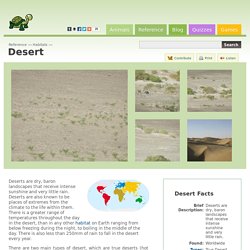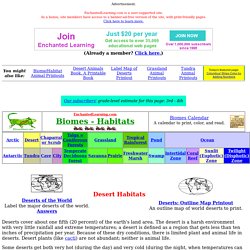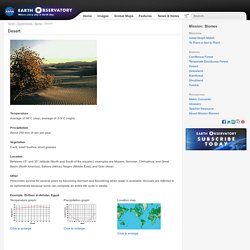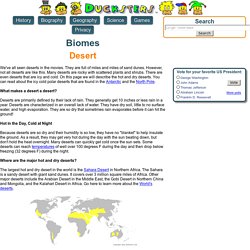

American Deserts. The prickly pear is a cactus with wide, flat stems called cladodes.

It is defended by long, sharp spines. Ground squirrel Ground squirrel Ground squirrels live in burrows underground. They are often hunted by rattlesnakes. Squirrels › The organ pipe cactus has flowers that open only at night. Bobcat Bobcat This short-tailed cat preys on smaller mammals such as jackrabbits. Small cats › Gila monster Gila monster The gila monster is a hunting lizard. Venomous lizards › Coyote Coyote These adaptable animals will eat fruit and insects, as well as live prey and the dead remains of other animals. Coyote › Western diamondbackrattlesnake Western diamondbackrattlesnake This venomous snake seeks out small mammals to eat. Rattlesnakes › The kangaroo rat hops very quickly on its hind legs. Collared lizard Collared lizard Fast-moving lizards race across the desert, chasing insects and other small animals for their food.
Heat regulation › This tough desert shrub produces orange flowers in spring. Desert - Reference. Deserts are dry, baron landscapes that receive intense sunshine and very little rain.

Deserts are also known to be places of extremes from the climate to the life within them. There is a greater range of temperatures throughout the day in the desert, than in any other habitat on Earth ranging from below freezing during the night, to boiling in the middle of the day. There is also less than 250mm of rain to fall in the desert every year. There are two main types of desert, which are true deserts (hot deserts), which are found on either side of the tropics and semi-deserts, which are found on every continent often far from the tropical regions.
The main difference between a true desert and a semi-desert is that a semi-desert receives at least twice as much rain per year as a true desert. The main exception to this is the Gobi desert, which is the largest desert region in Asia. Enchanted Learning. Advertisement.

EnchantedLearning.com is a user-supported site. As a bonus, site members have access to a banner-ad-free version of the site, with print-friendly pages.Click here to learn more. (Already a member? Click here.) Deserts cover about one fifth (20 percent) of the earth's land area. Some deserts get both very hot (during the day) and very cold (during the night, when temperatures can drop well below freezing). Different animals live in the different types of deserts. Desert Extremes: The biggest desert is northern Africa's Sahara Desert; it covers roughly 3,500,000 square miles (9,065,000 square kilometers). Some of the largest deserts in the world: Desert activities to print: National Geographic. Far from being barren wastelands, deserts are biologically rich habitats with a vast array of animals and plants that have adapted to the harsh conditions there.

Some deserts are among the planet's last remaining areas of total wilderness. Yet more than one billion people, one-sixth of the Earth's population, actually live in desert regions. Deserts cover more than one fifth of the Earth's land, and they are found on every continent. A place that receives less than 10 inches (25 centimeters) of rain per year is considered a desert. Deserts are part of a wider classification of regions called "drylands. " And despite the common conceptions of deserts as dry and hot, there are cold deserts as well. Desert animals have adapted ways to help them keep cool and use less water. Desert plants may have to go without fresh water for years at a time. NASA: Earth Observatory. Temperature Average of 38°C (day), average of -3.9°C (night) Precipitation About 250 mm of rain per year Vegetation Cacti, small bushes, short grasses Location Between 15° and 35° latitude (North and South of the equator); examples are Mojave, Sonoran, Chihuahua, and Great Basin (North America); Sahara (Africa); Negev (Middle East); and Gobi (Asia) Other Perennials survive for several years by becoming dormant and flourishing when water is available.

Example: El-Oasr el-Akhdar, Egypt Description Desert biomes are the driest of all the biomes. Since desert conditions are so severe, the plants that live there need to have adaptations to compensate for the lack of water. Science for Kids. We've all seen deserts in the movies.

They are full of miles and miles of sand dunes. However, not all deserts are like this. Many deserts are rocky with scattered plants and shrubs. There are even deserts that are icy and cold. On this page we will describe the hot and dry deserts. What makes a desert a desert? Deserts are primarily defined by their lack of rain. Hot in the Day, Cold at Night Because deserts are so dry and their humidity is so low, they have no "blanket" to help insulate the ground. World Biomes.